Clinical Center News
Longtime platelet donor marks 400th draw
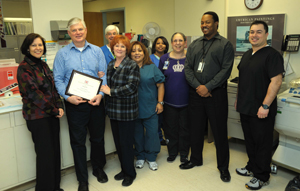 |
|
Robert Prior (second from left) of Fairfax, Va., was honored with a plaque commemorating his 400th platelet donation to the NIH Blood Bank on Feb. 23. He has given at least once a month since 1978. With him are (from left) Dr. Susan Leitman, chief of Blood Services, and Blood Bank employees Janet Miranda, Phyllis Byrne, Zulda Rached, Janeen Thomas-Sanders, Rosella Freeman, Hal Wilkins, and Juan Salgado.
|
Robert Prior understands selflessness. “You can’t always take, you have to give sometimes,” Prior said in the midst of his 400th donation to the NIH Blood Bank’s platelet center.
“I do it to give something back,” said Prior, who hit 400 platelet donations, a Blood Bank record, on Feb. 23. “It makes me feel good to know I did what I can.”
Prior, 64, first donated blood to the American Red Cross as an 18-year-old volunteer fire fighter before someone suggested he look into platelet donation at NIH. He started coming in 1978 every Saturday, eventually dropping to bimonthly, and now making the trip from Fairfax, Va., once a month.
Asked the difference between blood and platelet donation, Prior quipped, “Bigger needle.” Platelets are colorless, clotting agents that travel in a person’s blood. Patients with diseases such as aplastic anemia or who are undergoing cancer treatment cannot produce their own platelets.
“A lot of donors get started if they have a family member or a friend at the Clinical Center or with cancer, and they want to help,” said Phyllis Byrne, managing director of the platelet center.
For Prior, though, it was the other way around. Twenty years ago, his son was diagnosed with Wilms’ tumor, a primarily pediatric kidney cancer. “I realized how much he was depending on other people,” Prior said.
Byrne is continuously impressed and amazed with Prior’s positive attitude and commitment to helping others. Even when he lived across the Bay Bridge on Kent Island, more then 70 miles away, he still came in for his monthly visits, she said. “It amazes me that someone is so dedicated,” Byrne commented proudly. “He is always smiling and laughing.”
The sentiment is mutual. “I have never been here with people who are just going through the motions. They are always empathetic, caring, and dedicated,” Prior said.
As Prior began his procedure, which can take up to 90 minutes, an orange-frosted cake and a plaque commemorating his generous donations over the past 30 years waited for him in the next room.
Not ready to quit anytime soon, Prior said with a smile, “Next visit I’ll be starting my next 400!”
Back to top
Computerized process itemizes NIH spending
A searchable, categorized report on how the NIH funded each of its 215 historically recorded classifications of disease, condition, or research efforts in the fiscal year was pushed public in January 2009.
The Research, Condition, and Disease Categorization (RCDC) process—an electronic coding system—makes more transparent how the NIH spent its dollars the previous year, a goal consistent with the efforts of the Obama administration.
“We often hear from members of the public and even the investigators that we support that NIH is a black box, and they want more transparency into how we spend our money and results of those investments in research,” said Dr. James Onken, special assistant to the acting deputy director for extramural research. RCDC will help “open up that black box” and provide more reliable, consistent means of reporting total funds spent, Onken said.
The RCDC process developed out of a 2006 addition by Congress to the NIH Reform Act and earlier National Academy of Sciences recommendations that NIH build a tool to categorize its research. Consistent across all institutes and centers, RCDC reports on NIH research grants, research and development contracts, and intramural research. The Division of Program Coordination, Planning, and Strategic Initiatives (DPCPSI) managed and coordinated the development of RCDC, which uses advanced data- and text-mining computer technology. The Electronic Research Administration in the Office of Extramural Research and the Center for Information Technology supported DPCPSI in the creation of the RCDC system.
In a town hall meeting January 14, Dr. Timothy Hays of DPCPSI, RCDC project director, demoed how to access the new, detailed reports, sortable under a variety of tabs including grant number, institute or center, and public health area of interest. These data can be downloaded and printed in formats including PDF, and Microsoft Word, Excel, and PowerPoint.
Hays pointed out that RCDC does not affect the way the NIH funds research or determines its research priorities. It also does not change the way the NIH makes awards throughout the year for medical research, or the way researchers apply for grants.
Questions at the demonstration addressed logistics—when the data will be updated and how categories are assigned. Hays reported RCDC data will be updated on a yearly basis, posted with the release of the president’s budget. The current 215 categories are defined by Congress as special interest areas.
Hays hopes to add additional categories in a few years when the system receives enough feedback.
The RCDC report lives on the Research Portfolio Online Reporting Tool Web site, a single access point to a variety of NIH-related data, such as analyses of research activities, expenditures, and results. View that information and more at http://report.nih.gov.
Back to top
Bedside-to-Bench Award develops treatment to kill pain receptors
By Bill Schmalfeldt
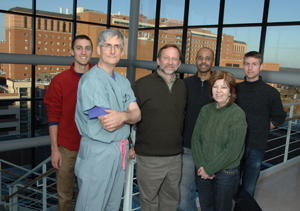 |
|
Developing a new pain-relief treatment is (from left) Brian Bates, NIDCR; Dr. Andrew Mannes, CC; Dr. Michael Iadarola, NIDCR; Dr. Kendall Mitchell, NIDCR; Ruth Yaskovich, NIDCR; and Jason Keller, NIDCR.
|
Can killing the messenger—pain-responsive neurons in the sensory ganglia—be a practical way to manage intractable pain? That is the central question in research being done by Dr. Michael Iadarola, chief of the Neurobiology and Pain Therapeutic Section at the National Institute of Dental and Craniofacial Research, and Dr. Andrew Mannes of the Clinical Center’s Department of Anesthesia and Surgical Services.
Iadarola’s team is about to launch a Phase I clinical trial of a new pain-relieving drug called resiniferatoxin, a single-shot dose of analgesic that lasts forever. “We call it a ‘fire and forget’ missile,” he said. The target neurons connect the body to the spinal cord, and interrupting this one specific class of pain-sensing neurons will eliminate the connection and some types of pain.
This research was funded, in part, by a Bedside-to-Bench Award Iadarola received from the CC in 2001, and the clinical trial is the culmination of a long journey, both for the drug and the doctor.
The experimental drug comes from Morocco where it is isolated from latex of the plant Euphorbia resinifera. The latex from this cactus-like plant has been used for #topical pain relief for thousands of years. Resiniferatoxin has a molecular structure similar to capsaicin—the active ingredient in hot peppers—and binds to the same pain receptor in a neuron as capsaicin, but 500 to 1,000 times more tightly.
Capsaicin causes an ion channel called TRPV1 in the sensory neuron to open briefly allowing a small amount of calcium and sodium ions to flow into the cell, which generates the burning sensation one associates with eating a hot pepper. Resiniferatoxin holds the channel open for a much longer period, flooding the cell with enough calcium to kill it. Within an hour, most neurons with a TRPV1 channel are compromised or dead. They do not grow back. Not all neurons have TRPV1 channels, and resiniferatoxin does not affect those that do not.
TRPV1-positive neurons are contained in the dorsal root ganglion, and their nerve endings are in the skin, where they respond to sensations of moderate heat, and in the internal organs, where they seem to be the main messengers of pain from cancer and inflammation.
Iadarola credited the Bedside-to-Bench Award for getting the ball rolling in the translational direction of this research. “We had a basic science laboratory, and we had no mechanism to take findings from live-cell imaging with a microscope and translating that into a clinical protocol. Getting the Bedside to Bench Award is what got us started on what has been a long road,” he said.
Found successful in the treatment of canines at the University of Pennsylvania Medical School, the drug’s efficacy and lack of side effects were very strong incentives to move into human testing, Iadarola said. This transition occurred with the help of the Division of Pharmacotherapies and Medical Consequences of Drug Abuse of the National Institute of Drug Abuse, experts on the development of treatments for addictive drugs.
First, the research team needed a clinical-grade drug. “That was a very long adventure,” Iadarola said. But after a few false starts, they have enough of the experimental medication to use in studies for several years, which the Bedside-to-Bench funds made possible.
The team is about to kick off the trial with their first patient, with hopes to enroll as many as 24 into the study. Mannes will inject the resiniferatoxin into the cerebral spinal fluid space around the spinal cord. The patient is placed under general anesthesia for 60 to 90 minutes while the drug kills off the pain neurons in the spinal cord. If the treatment is successful, the patient should no longer have to rely on high doses of morphine or other opioids to control pain.
“We hope this is the beginning of a much bigger program for pain control,” Iadarola said. “This is a very versatile agent and approach. We can use this not only in people with end stage cancer, but hopefully in a lot of other specific pain conditions if we can demonstrate both safety and efficacy.”
Back to top
Officials from Russia’s version of the FDA visit the Clinical Center
Health-policy makers from Rozdravnadzor, the Russian equivalent of the FDA, were at the Clinical Center in January during a visit to NIH to learn more about US clinical and research practices, policies, and private-public partnerships. While here, the group met with CC Director Dr. John I. Gallin (center) and Dr. Frederick P. Ognibene (right), director of the CC’s Office of Clinical Research Training and Medical Education. Discussions included the possibility of offering the CC’s course “Introduction to the Principles and Practice of Clinical Research” in Russia. With them are Elena Barmanova (left), deputy head of the Department of Registration of Medicines and Medical Devices; Alexey Terekhov, advisor to the head of Rozdravnadzor; and Olga Mirolyubova, head of the licensing division.
Back to top
Renowned author and surgeon examines medical error
In small-rimmed spectacles and a striking green bowtie, Dr. Atul Gawande told stories to a crowd filling the seats of Lipsett Amphitheater on February 11.
Gawande recounted astounding cases, including his “single greatest save,” from his exceptionally successful medical career in his Clinical Center Great Teachers Grand Rounds lecture, “The Art of Failure.” A woman who forewent surgery for an abdominal aortic aneurysm; a vibrant 23-year-old with necrotizing fasciitis; and his own flu-suffering, preteen daughter were examples of how doctors can be wrong.
A staff writer at The New Yorker, Gawande is a general and endocrine surgeon at Brigham and Women’s Hospital and the Dana Farber Institute, and associate professor in the Department of Surgery at Harvard Medical School and the Department of Health Policy and Management at the Harvard School of Public Health. In 2006, Gawande was named director of the World Health Organization’s global campaign to reduce surgical deaths and received a MacArthur Award for his writing and public health work.
Dr. Paul H. Plotz, chief of the Arthritis and Rheumatism Branch of the National Institute of Arthritis and Musculoskeletal and Skin Diseases, introduced the great teacher. “I think that Atul Gawande may be a medical Michael Jordan,” Plotz said, basing his comparison on the basketball player’s consistently different and dazzling approach to his game.
“What is striking is still how fundamentally human our endeavor is in medicine,” said Gawande. “What we think about today, and what you can’t help but think about walking on to this campus for the first time, as I did today, is the massive amount of knowledge, and powerful ability, and technology that we have developed in modern 21st century medicine. But what you still find when you get in close is the messier reality of an individual doctor and an individual patient trying to sort through it all.”
In his books, Complications: A Surgeon’s Notes on an Imperfect Science and Better: A Surgeon’s Notes on Performance, Gawande has explored why things go right and things go wrong in medicine.
He was involved in a study that looked at 15,000 medical charts of patients admitted to 28 hospitals in Utah and Colorado in a year of study. The research team found that 3 percent of the time something went wrong resulting in a genuine harm such as death or disability. Half of that 3 percent were avoidable mistakes where an individual or institution failed to properly apply the existing standard of care, Gawande said. An example he gave was an incorrect drug dosage leading to renal failure.
The explanation for the other 1.5 percent of cases with error falls on mystery and uncertainty, said Gawande. There are still many conditions doctors and scientists do not understand. Chronic pain is one problem that they know too little about.
“Even if our errors were eliminated and the science of human afflictions were to be completely understood, there is still an unavoidable uncertainty in what we do. And I think that uncertainty is what makes perfection unachievable and also what makes medicine so hard,” Gawande said.
The patient stories he presented play off his reasoning for failure in medicine—though fortunately all three cases ended favorably. The abdominal aortic aneurysm patient continues to live independently despite going against her doctors’ wishes to operate. Her body mysteriously did not respond to a usually debilitating disease. Uncertainty on the presence of necrotizing fasciitis prompted Gawande to operate, though all signs pointed to harmless cellulitis. The more serious condition had, in fact, taken over the patient’s leg, but the team was able to save the appendage. Gawande’s daughter suffered slightly as the result of a mistake in a test for influenza. First ruled out as the cause of her ill feelings, she was later diagnosed with the common disease.
Gawande spoke later the same day in the Wednesday Afternoon Lecture Series on “The Science of Failure.” Videocasts of both lectures are available at http://videocast.nih.gov.
Back to top
Oncologic imaging focus of Doppman lecture
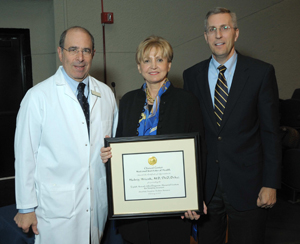 |
|
Dr. John I. Gallin, CC director (left), and Dr. David Bluemke, director of the CC’s Radiology and Imaging Sciences, flank Dr. Hedvig Hricak, who delivered the Eighth Annual John Doppman Memorial Lecture.
|
The Eighth Annual John Doppman Memorial Lecture for Imaging Sciences hosted a leading researcher who knew the former chairman of the Clinical Center’s Diagnostic Radiology Department well.
“He was such a good and loyal friend to many of us,” Dr. Hedvig Hricak said of Doppman, who retired from the CC in 2000 and died that August.
Hricak is chairman of the Department of Radiology at Memorial Sloan-Kettering Cancer Center and professor of radiology at the Weill Medical College of Cornell University. Her lecture—“Oncologic Imaging: Endless Horizons”—February 25 in Lipsett Amphitheater was part of the CC Grand Rounds series.
Number three on Forbes magazine’s Five Technologies Set to Change the Decade is molecular imaging, Hricak pointed out. New developments give radiologists a clearer, more precise picture, especially useful in cancer research.
“As we advance in imaging technology, it is increasingly frightening how little we knew yesterday, Hricak said to the crowd that included Doppman’s wife, son, and daughter-in-law. She showed the same patient’s bone scan and FDG PET and FDHT PET scans, all taken within a matter of days. With each advancement in technology, more lesions were visible.
She noted imaging key biological markers and targeted imaging as the next wave of research. “It has never been a better time to be in molecular, oncologic imaging,” Hricak said. “Seeing our work make people better is so rewarding.”
Back to top
Grady named to new bioethics role
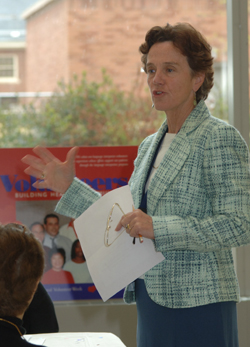 |
|
Dr. Christine Grady, seen here at a 2007 volunteer appreciation event, was recently named deputy chief of the CC Bioethics Department.
|
Dr. Christine Grady recently assumed the role of deputy chief of the Clinical Center’s Bioethics Department to assist in oversight of budget, personnel, and other administrative matters. Additionally, while Bioethics Chief Dr. Ezekiel Emanuel is on an extended detail to the Office of Management and Budget, Grady has agreed to serve as acting chief of the department. As special advisor to the director for health policy, Emanuel is working on a variety of health policy issues but mainly leading the Office of Management and Budget’s health care reform efforts.
Grady joined the CC in 1983 as a clinical nurse specialist, focused primarily on HIV and other immunological and infectious diseases. After a few years as assistant director for clinical science at the National Institute of Nursing Research and completion of a doctorate in philosophy, she returned to the CC to join the Bioethics Department, where she has served as the head of the Section on Human Subjects Research for the last 10 years. As a tenured scientist, Grady’s research areas include informed consent, subject recruitment, incentives, vulnerability, and international research ethics.
“With a background in nursing, Christine Grady rounds out her role with a rich clinical perspective, adding valuable insights into clinical ethical issues,” said CC Director Dr. John I. Gallin.
Back to top
Researchers study the nuances of genomic medicine research
The painting “The Great Wave” by K. Hokusai began a recent two-part Grand Rounds lecture, communicating the climate of the current genomic era.
“Such waves of data, technology, and opportunity keep hitting the shore,” said Dr. Eric Green, scientific director of the National Human Genome Research Institute at the January 28 lecture in Lipsett Amphitheater.
Green and Dr. Leslie Biesecker, chief of the NHGRI Genetic Disease Research Branch, spoke on “The Emerging Paradigm of Clinical Genomics.” Green spoke first on the technologic developments and genomic advances, before Biesecker took the podium to describe a major new genomics project recently launched at the Clinical Center.
The Human Genome Project finished the first human genome sequence in 2003, but there will be many steps leading to the realization of genomic medicine—“health care tailored to the individual based on genomic information,” Green said. Three of these steps are elucidating human genome function, empowering human genetic studies, and implementing new DNA sequencing technologies.
By comparing the human genome sequence to those of animals such as mouse, dog, and platypus, researchers have gained insight into which of the 3 billion DNA letters in the human genome are important for human development and function. Scientists believe that 5 to 10 percent of the letters are functionally important—but only 2 percent of them directly code for protein. The others are non-coding DNA, regulating genes and involved in packaging and replicating chromosomes, Green said.
“We are trying to learn the language of the human genome sequence. There’s a lot to be learned—subtle features of grammar, syntax, and word choice—and all of this flows together to create the genetic language,” said Green.
The 3 to 5 million differences in the genetic sequence between any two people are responsible for making each individual unique. Not all variants have a negative effect. “What is very relevant to what is going on in this Clinical Center are those variants that confer risk to human disease, and understanding those variants will be critical for the practice of genomic medicine,” Green said.
Current research tries to identify the genetic variants that result in an increased likelihood of disease. The field has seen much success thus far, recognized by the journal Science as the 2007 Breakthrough of the Year.
An overview of a new NHGRI-sponsored project—ClinSeq—was presented by Biesecker. Begun in January 2007, the study has already enrolled more than half of its planned cohort of 1,000 patients. The project’s main goals are to develop a robust infrastructure for the generation and use of genomic data in a clinical research setting and to understand how to interact with subjects concerning their genomic data. It is a common question in genomics—how much or how little do patients want to know about their genetic predisposition to disease?
“It is essential that we do not forget the patients, the subjects that we work with … We have to develop ways to interact with the subjects that protect their interests and advance the research agenda,” Biesecker said.
Back to top
Hospitality offers answers to frequently asked questions
The Clinical Center complex houses 6,000 employees (2,000 CC staff, the rest from other institutes and centers) and almost 3.5 million square feet. Such a massive structure can be intimidating to even those who walk the halls each day. For a newcomer, it can be almost frightening.
Denise Ford, chief of CC Hospitality Services, and Michael Alexander, hospitality services coordinator, reviewed some basics staff should know if asked by someone confused by the surroundings.
NIH staff from other buildings or from off-campus often come to Building 10 for lectures offered in Lipsett Amphitheater or Masur Auditorium. From the north entrance, a visitor can walk straight back through the Hatfield Building, go through the sliding glass doors and follow the overhead signs to the left to find the Lipsett Amphitheater. For the Masur Auditorium, proceed through the same sliding glass doors, follow the detour signs to the right to the auditorium, found near the main elevators of the Magnuson Building.
The B1 corridor is a popular destination for visitors. With a larger cafeteria, the NIH Credit Union, the recreation and welfare gift shop, the Foundation for Advanced Education in the Sciences bookstore and business office, a convenience store, and a beauty shop, it is a common area of interest for patient family members, staff, and visitors. These facilities are near the main elevators on the B1 level.
Another place patients and visitors may ask about is the Interfaith Chapel. Direct people to the north elevators in the Hatfield Building; the chapel is between the east and west elevator banks on the seventh floor.
When an answer is unknown, direct the questioner to one of three main hospitality desks in the CC. They are located just within the
|
2008 Clinical Center activity
|
|
|
Admissions
|
6,105
|
|
New Patients
|
9,460
|
|
Average Daily Inpatient Census
|
149
|
|
Outpatient Visits
|
90,254
|
|
Active Onsite Protocols
|
1,449
|
|
Open Beds
|
85
|
|
Onsite Principal Investigators
|
478
|
main entrance in the north lobby, on the B1 parking level near the south elevators, and near diagnostics where the Magnuson and Hatfield Buildings meet. Wayfinding kiosks are located near those hospitality desks as well as on floors 3, 5, and 7 off the central elevators. Kiosk touchscreens direct to over 250 locations throughout the CC with printable maps, or simply lift the courtesy telephone, which rings directly to the main hospitality desk, to connect to someone who can assist.
“In trying to assist patients, we try not to say no to anyone,” Ford said. “We are very much about what we can do for you, not what we can’t do.”
Ford and Alexander stressed a way for patient care staff to help hospitality help patients—return wheelchairs. Missing wheelchairs is an increasingly alarming issue to escort and hospitality services employees. “My worst nightmare is that a patient who needs a wheelchair arrives at the Clinical Center entrance, and I do not have one to help him or her even get out of the car. That’s just a bad first impression,” Alexander said.
They believe the wheelchairs are often forgotten about or even “stashed” in clinics and patient wards, but the oversight can be costly one. Patients may be frustrated with poor service, and one patient late to an appointment because no wheelchair for transport could be found creates a domino effect. The rest of the day’s appointment schedule falls behind, said Ford.
Wheelchairs ready for return can be brought to the B1 parking level hospitality desk or a call can be placed to 301-594-3301 for pickup.
Back to top
News Briefs
New ways of promoting NIH jobs
The NIH Office of Human Resources announced two new outlets to recruit new employees to the NIH.
The first targets dual-career families job hunting at the same time. The NIH is a founding member of the recently launched Mid-Atlantic Higher Education Recruitment Consortium (MA-HERC), a collaborative response to the challenges of academic recruitment and retention. NIH employment positions are posted on the MA-HERC online job board attracting applicants who have family members applying for jobs at one of the other 19 member institutions. The MA-HERC Web site allows family members to search for employment opportunities by institution or region and view the results side-by-side. Visit the MA-HERC Web site at http://midatlanticherc.org.
The second new recruitment strategy is a job search engine on the Jobs at NIH Web site: http://jobs.nih.gov. Most jobs at NIH are advertised on USAJOBS, but there are some jobs—particularly scientific and research jobs—that are only advertised in scientific journals, on institute or center Web sites, or through the Research and Training Opportunities Web site. Scientists looking for NIH jobs had to go to multiple locations to see all of the positions available. With the new search engine job seekers will be able to search the majority of NIH positions in one place. All of the major NIH job repositories are included in the search, and other smaller repositories are being added each month.
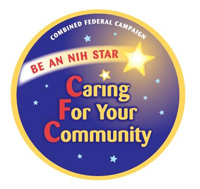 |
CC donates much more than CFC goal
In acts of pure generosity, Clinical Center employees far surpassed the original 2008 Combined Federal Campaign donation goal of $135,000. CC staff managed to give $181,042, even in trying economic times, to the number of philanthropies the campaign supports.
“Our keyworkers are the reason we had such an outstanding campaign; their creativity and commitment to help the needy was awesome. From our enormously successful, second-annual gift basket drawing that raised over $7,000, to smaller efforts such as a bake sale and a breakfast meeting with charities, the keyworkers went above and beyond. Everyone deserves a huge ‘Great Job!’” said the CC’s CFC deputy coordinator Debra Byram.
Computational powerhouse marks 10th year
The Biowulf Cluster has provided massive computational power for the past decade. The NIH’s biomedical cluster of computers linked over one, fast network to accelerate data output and analysis celebrated its 10th birthday at a recent symposium sponsored by the NIH Center for Information Technology. CIT manages Biowulf, which serves 19 of the 27 NIH institutes and centers.
A play on the name of the original computer clusters developed by NASA and called Beowulf after an Old English poem, the NIH version Biowulf lets researchers produce data at a drastically reduced length of time. Research that otherwise would have taken weeks is now done in minutes.The supercomputing resource accelerates intramural research in many fields: genomics, bioinformatics, structural modeling, molecular dynamics, statistics, and imaging.
Dr. Ronald Summers of the Clinical Center’s Radiology and Imaging Sciences uses the concentrated power of Biowulf to find and capture colon polyps in a three-dimensional image using noninvasive CT scans. This virtual colonoscopy computer-aided polyp detection technology is licensed by the NIH and pending FDA approval.“It is our hope that this new technology will encourage more people to be screened for colon cancer, the second leading cause of cancer deaths in the United States,” Summers said.
Art show looking for submissions
The 2009 NIH Juried Art Show is taking submissions. Open to all scientists, staff, and contractors currently working at the NIH (including fellows and medical students), the deadline is March 20. The works chosen will be shown in the hall near the NIH Library. Artwork can be any medium, except sculpture, due to lack of space. Pieces may be framed no wider than 30 inches across.
To be considered for the show, submit a disc or slides of artwork with a description of materials used to: Tyrone Spady, Cancer Genetics Branch/NHGRI, Bldg. 50, Rm. 5343. The show’s opening will take place May 4.
Back to top
NIH commemorates father of evolution Darwin’s birthday
In note of renowned naturalist Charles Darwin’s 200th birthday on Feb. 12, the Clinical Center, the National Human Genome Research Institute, and the NIH Library of Medicine held events, celebrating, too, the 150th year since the publication of Darwin’s On the Origin of Species.
Darwin is credited with setting science on a new course in the 19th century by introducing evolution as the unifying concept in all of genetics and biology. Born in Shrewsbury, England in 1809, Darwin published his influential, scientific text 50 years later.
 |
|
This pelican sitting in a mangrove tree was photographed by NHGRI Scientific Director Dr. Eric Green on a trip to the Galapagos Islands, the place Charles Darwin conducted studies that led to his famed On the Origin of Species. Adult pelicans can be identified by their white necks and brown to black lower bodies. Juveniles tend to have gray faces and brown bodies.
|
A rare first edition of On the Origin of Species is on display in the NLM exhibit “Rewriting the Book of Nature: Charles Darwin & the Rise of Evolutionary Theory,” which also features other books by Darwin and the scientist’s photos and letters. The exhibition in the NLM History of Medicine Division Reading Room runs to July 2, 2009, and again from Sept. 3 to Dec. 31, 2009.
Another exhibit in honor of Darwin’s birthday sat in the East Gallery and the East Alcove Gallery on the first floor of the CC’s Hatfield Building from November 2008 through February 2009. Twenty photographs submitted by NIH employees and patients show the beauty of the Galapagos Islands, west of continental Ecuador in the Pacific Ocean, where Darwin studied.
On Feb. 12, NHGRI hosted a symposium of genetic researchers commenting on their work, made possible by Darwin’s legacy. “I think what we all want to say is thanks. His work laid a foundation for the kind of science we now can do,” said NHGRI Scientific Director Dr. Eric Green. The meeting—“Darwin at 200”—in Masur Auditorium featured talks by investigators from NHGRI; Arizona State University; Howard Hughes Medical Institute; University of California, San Diego; and Harvard FAS Center for Systems Biology.
Later that same day, NHGRI and the Smithsonian Institution's National Museum of Natural History teamed to present to high school students from the Washington region a distinguished panel of speakers on #topics from historical perspectives of Darwin to evolution and medicine.
NLM will also hold a symposium, marking the publication of On the Origin of Species with “Finished Proofs?” on Oct. 1, 2009, in the Lister Hill Auditorium (Bldg 38A). Leading historians and scientists will explore changing and contested understandings of Darwinian theory over the last 150 years.
“Motion Picture Evolution,” a film-series shown Wednesdays from Sept. 16 through Oct. 28, 2009, at NLM, will show evolutionary movies and television programs. Organizers promise lots of dinosaurs and cavemen. Visit www.nlm.nih.gov for more information.
Back to top
Book collection spotlights authors among NIH clinician-scientists
A new display outside the medical board room on the fourth floor of the Hatfield Building showcases a sampling of textbooks recently published by intramural clinician-scientists at NIH. Rachael Schacherer, special assistant to the NIH CC chief financial officer Maria Joyce, reviews some of the literature in the collection.
Back to top
Participants sought for trials
More information on the following studies can be found at http://clinicalstudies.info.nih.gov/ or by calling 1-866-444-2214 (TTY: 1-866-411-1010).
Looking at the role of genes/hormones in pelvic pain
A clinical research study (04-CH-0056) sponsored by the National Institute of Child Health and Human Development is looking for healthy women age 30 to 50 to investigate the role of hormones and genes in pelvic pain and explore better approaches to treatment. All study-related tests are provided at no cost. Compensation is provided.
Healthy volunteers needed for stem cell donation
Healthy volunteers are needed for a study (06-DK-0142) sponsored by the National Institute of Diabetes and Digestive and Kidney Diseases designed for the collection of stem cells for use in research studies to gain insight into blood diseases. If you are 18 years of age or older, please consider participating. All study-related tests are provided at no cost. Compensation is provided.
Natural history study to track brain development in twins
The National Institute of Mental Health is seeking same-sex fraternal twins 5 to 20 years of age to participate in a study (89-M-0006) of brain development in healthy children. There is no cost for study-related tests. Compensation is provided.
Back to top
New clinical research protocols
The following new clinical research protocols were approved in January:
Phase 1 Trial of Siplizumab and Dose-Adjusted EPOCH-Rituximab (DA-EPOCH-R) in T and NK-Cell Lymphomas, 09-C-0065, John E. Janik, MD, NCI
A Qualitative Exploration of the Impact of Positive BRCA 1/2 Mutation Status on the Lives of Young Women, 09-C-0074, Mark H. Greene, MD, NCI
Randomized Pilot Study for the Treatment of Cutaneous Leiomyomas with Botulinum Toxin, 09-C-0072, Edward W. Cowen, MD, NCI
Surgical Interventions for Moderate Ischemic Mitral Regurgitation, 09-H-0050, Vandana Sachdev, MD, NHLBI
Pilot Study of Mitochondrial Biology in Human Platelets, 09-H-0068, Michael N. Sack, MD, NHLBI
Pilot Study of MRI-Guided High Intensity Focused Ultrasound Ablation of Uterine Fibroids, 09-CH-0063, Pamela Stratton, MD, NICHD
Long-Term Follow-Up of HALT-C Sustained Virologic Responders, 09-DK-0067, Marc G. Ghany, MD, NIDDK
The Use of a Distress Thermometer in a Pediatric Research Setting: An Exploratory, Pilot Study, 09-M-0022, Maryland Pao, MD, NIMH
Brain-Gut Interactions in Overweight and Normal Weight Patients with Chronic Abdominal Pain, 09-NR-0064, Wendy A. Henderson, PhD, CRNP, NINR
Back to top
Upcoming Events
Clinical Center Grand Rounds, 12pm, Lipsett Amphitheater
Lectures will be videocast at http://videocast.nih.gov.
March 4, 2009
Understanding and Ensuring the Quality of Cellular and Gene Therapies Through Science and Regulation
Keith Wonnacott, PhD
Chief, Cellular Therapies Branch, Center for Biologics Evaluation and Research, FDA
The Use of Molecular Assays to Assess the Potency of Cellular Therapies
David Stroncek, MD
Chief, Cell Processing Section, Department of Transfusion Medicine, CC
March 11, 2009
Contemporary Clinical Medicine: Great Teachers
Prevention of Transmission of HIV-1: Clues from the Early 21st Century
Myron S. Cohen, MD
Associate Vice Chancellor for Global Health
J. Herbert Bate Distinguished Professor of Medicine, Microbiology and Immunology, and Public Health Director, UNC Institute for Global Health and Infectious Diseases
Chief, Division of Clinical Infectious Disease
University of North Carolina at Chapel Hill School of Medicine
March 18, 2009
Post-Katrina Health Care: Present Status and Future Considerations
Keith C. Ferdinand, MD
Chief Science Officer, Association of Black Cardiologists
Clinical Professor, Division of Cardiology, Emory University
Recovery and Rebuilding of the Safety Net Post-Katrina
Karen B. DeSalvo, MD, MPH, MSc
C. Thorpe Ray Chair, Internal Medicine
Vice Dean, Community Affairs and Health Policy
Chief, General Internal Medicine and Geriatrics
Tulane University School of Medicine
March 25, 2009
Trapped in TRAPS: How Abnormal Trafficking and Accumulation of Mutant TNFR1 Leads to Inflammation in the TNFR1-Associated Periodic Syndrome (TRAPS)
Richard Siegel, MD, PhD
Chief, Immunoregulation Section, Autoimmunity Branch, NIAMS
Two Diseases That Teach Us About the Role of IL-1 in Human Inflammation: Neonatal-Onset Multisystem Inflammatory Disease (NOMID) and Deficiency in the IL-1 Receptor Antagonist (DIRA)
Raphaela Goldbach-Mansky, MD
Acting Chief, Translational Autoinflammatory Disease Section, NIAMS
Back to top
This page last updated on 12/14/2017


 The information on this page is archived and provided for reference purposes only.
The information on this page is archived and provided for reference purposes only.